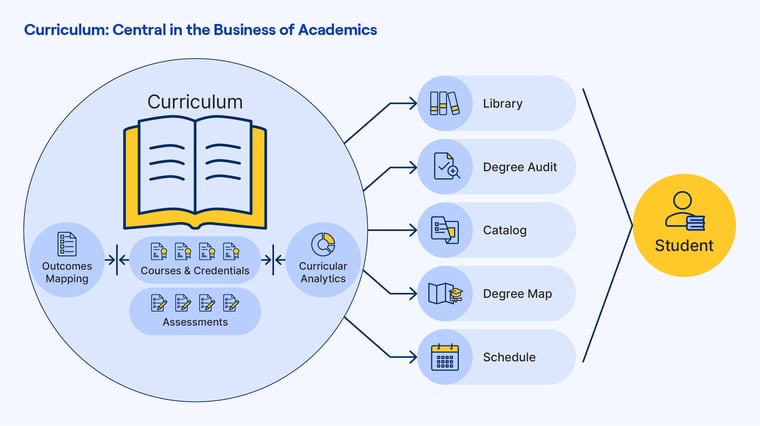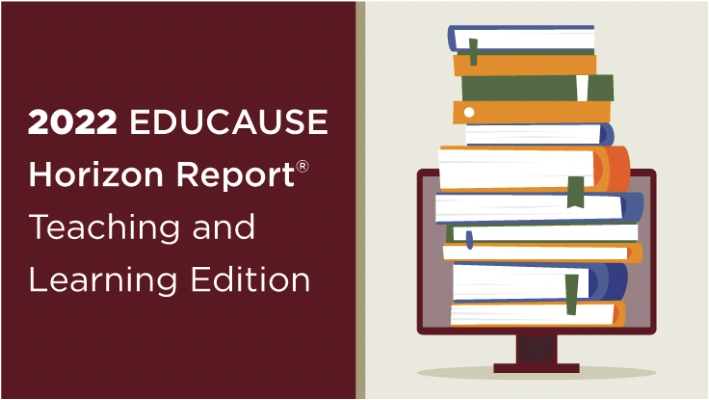2022 EDUCAUSE Horizon Report response: curriculum, the hidden key
The 2022 EDUCAUSE Horizon Report on teaching and learning continues to set a high standard for highlighting and explaining the challenging issues facing higher education. The 2022 report features trends and technologies impacting student success in areas of hybrid learning, micro-credentials, and skill-based learning.
Each trend referenced in this report points toward technological and practical solutions, but ultimately it is up to the institutional leadership teams to determine the relevance, priority, and impact of any given solution. And in spite of the challenges that appear in the most urgent need of attention, the solution capable of affecting the most meaningful change is the one that addresses the root cause of the school’s challenges. It reminds me of the water problem we discovered shortly after buying our home.
After heavy downpours, water would inexplicably seep into the first floor of our split-level home. We were advised to install bigger pumps and dehumidifiers in the basement, and then, when that didn't work, we were advised to modify walls in the basement which meant removing cabinets and forcing us to change the way we used the space. Each 'fix' was more expensive than the last, and neither of them completely worked. Thankfully, we found a specialist who looked at the property holistically in an effort to solve the root of the problem – addressing the way water was draining from the back of the property right into the wall of our house.
Suppose you analyze the challenges many colleges and universities experience today. In that case, they are not dissimilar to a homeowner’s challenges: new problems previous administrators did not see coming, creating challenging situations resulting from the lack of assessment, planning, or preparation. In each case, colleges and universities seek solutions to their problems, often resulting in a trial and error approach without finding the root cause – the curriculum.
The curriculum is the root cause of wider institutional issues – solve it and other issues will dissipate
The 2022 EDUCAUSE Horizon report on teaching and learning highlights many issues that are connected to the curriculum and how it is managed. Today’s challenges range from trying to pivot to survive a pandemic to student sentiment toward the high cost of degree attainment to realizing that hybrid or hyflex learning is here to stay (2022). These realizations coincide with the growing expectation that students need demonstrative assurance of learning to retain employment in today’s job market. All curricular problems.
The COVID pandemic highlighted the need to read and react to environmental influences that impact the core of institutions of higher learning – their curriculum. An example of a rapid response driven by the pandemic is the scramble to remote self-learning. Before the pandemic, programs supporting graduates in careers like applied behavioral analysts (ABA) might not cover ‘telehealth’ in the curriculum, which quickly came to light during the pandemic (Neely, 2022). Telehealth requirements forced ABA’s to educate themselves on these skills to keep community health programs moving forward when they could not perform in-clinic sessions or conduct at-home visits. However, curriculum challenges predate the current pandemic.
Leaders at colleges and universities delight in the outputs of analytics tools, but these tools often misdiagnose the root problem. Researchers at the University of North Dakota noted the College of Medicine learned firsthand the difficulty of being responsive at the start of the opioid crisis when school leaders could not quickly identify curricular alignment to addiction and treatment options (Nickum, Thormodson, & Francis, 2021). The absence of assessment and objective alignment to curriculum creates many problems, including the inability to quickly and easily show what students are learning in their programs. In these cases, a problem with scheduling or the accuracy of a student’s degree audit just masks the root cause, driving campus leaders to look for a quick fix. These issues are symptoms of an incomplete understanding of the curriculum.
Getting the best out of your curriculum
Curriculum mapping provides a better understanding of your curriculum and is as crucial to student success as reporting or dashboards are to institutional accreditation for campus leaders. The use of curriculum mapping visualizes the links between student assessment and the desired outcomes (Vashe et al., 2021). Curriculum mapping also provides financial benefits for campus libraries by providing a roadmap of acquisition, so they purchase collections that better meet the instructional needs of the school (Ramirez & Tabacaru, 2021). Heat maps then identify the timeline and impact of this assessment alignment to curriculum objectives, setting appropriate learning expectations for students while informing the faculty teaching the program curriculum (Clark et al., 2021). Solutions that provide a complete understanding and management of your curriculum help ease these downstream challenges highlighted in the EDUCAUSE Horizon report and help you recoup the investments in other solutions.
Curriculum: Central in the business of academics

The majority of trends and practices listed in the 2022 report relate to the business processes affecting students’ success, processes that branch from the root of an institution’s core business line – the curriculum.
Class schedules, degree audits, and the catalog are just three examples of critical functions that flow downstream from the curriculum. Each of those areas ultimately impacts student learning and success, but without putting your curriculum at the forefront of your institution’s strategy these downstream activities will remain only partially effective.
How CourseLoop supports a strategic focus on curriculum management
The design of the CourseLoop solution begins and ends with the student in mind. Our solution adds layers of functionality created to ensure data integrity, learning accountability, and content, resulting in easy-to-understand publications and degree maps. The modular platform provides holistic support across the entire curriculum lifecycle.
Currently, the CourseLoop Platform comprises seven solution modules to support curriculum management end-to-end, enabling you to:
- Capture and manage your curriculum with a data model purpose-built to support the design of robust, dynamic curricula for your students.
- Integrate your data with downstream systems.
- Simplify and streamline the approvals process with easy collaboration and meeting management.
- Manage periodic curriculum quality assurance reviews.
- Save time and eliminate manual tasks by automating processes.
- Map and visualize relationships between curriculum items like courses, assessments, and learning outcomes, to gain insights into the depth of learning, coverage, mastery, and coherency of your curriculum for continuous improvement.
- Evidence the assurance of learning for programs with downloadable maps – reducing the cost of compliance with internal and external accreditation exercises.
- Publish your curriculum to your modern, accessible student catalog with your brand for seamless blending with your website and powerful search-driven capability that supports student navigation, so they can find all the information they need to make an informed decision.
- Publish general content alongside your curriculum so students can easily find information about departments and institutional policies.
- Publish marketing content alongside your curriculum and use geo-tagging to direct the right information to the right students (e.g. domestic vs international).
- Create and publish standard progression pathways and personalized student study plans to support students’ meaningful engagement with the curriculum,
CourseLoop provides these capabilities, and much more.
The CourseLoop solution comes from a team passionate about higher education. Our goal is to help colleges and universities simplify the creation, governance, and publishing process surrounding your curriculum, an often-overlooked root cause of challenges facing higher education. We want to help you leverage our world-class suite of solution modules to reduce academic administration overhead and enable an effective and efficient approach to student success management.
Get in touch to find out how CourseLoop can help you.
References
Neely, L., Tsami, L., Graber, J., & Lerman, D. C. (2022). Towards the development of a curriculum to train behavior analysts to provide services via telehealth. Journal of Applied Behavior Analysis.DOI: 10.1002/jaba.904
Nickum, A., Thormodson, K., & Francis, M. (2021). Developing A Controlled Vocabulary for Curriculum Mapping: A Case Study [Article]. Science & Technology Libraries, 40(2), 214-223. https://doi.org/10.1080/0194262X.2020.1860184
Ramirez, D., & Tabacaru, S. (2021). Incorporating curriculum mapping as a method to increase approval plan precision [Article]. College & Undergraduate Libraries, 28(2), 165-179. https://doi.org/10.1080/10691316.2021.1902446
Ryan, C., Sarah, B., Jennifer, R., Karin, A. O., & Sharon, F. S. (2021). Creation of a novel simple heat mapping method for curriculum mapping, using pathology teaching as the exemplar [article]. BMC medical education, 21(1), 1-9. https://doi.org/10.1186/s12909-021-02808-3
Vashe, A., Devi, V., Rao, K., & Abraham, R. (2021). Establishing links between assessments and expected learning outcomes through curriculum mapping in a dental physiology curriculum. The National Medical Journal of India, 34(1), 40. https://search.ebscohost.com/login.aspx?direct=true&AuthType=shib&db=edsgea&AN=edsgcl.672270922&site=eds-live&scope=site&custid=s6527200 DOI: 10.4103/0970-258X.323445

